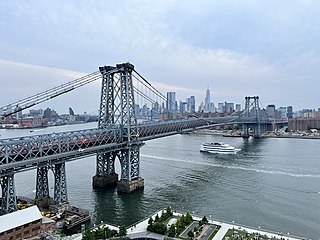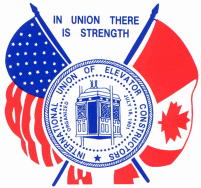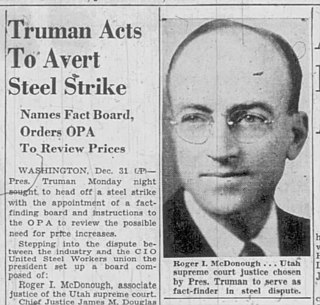Related Research Articles

The Brooklyn Bridge is a hybrid cable-stayed/suspension bridge in New York City, spanning the East River between the boroughs of Manhattan and Brooklyn. Opened on May 24, 1883, the Brooklyn Bridge was the first fixed crossing of the East River. It was also the longest suspension bridge in the world at the time of its opening, with a main span of 1,595.5 feet (486.3 m) and a deck 127 ft (38.7 m) above Mean High Water. The span was originally called the New York and Brooklyn Bridge or the East River Bridge but was officially renamed the Brooklyn Bridge in 1915.

The Lincoln Tunnel is an approximately 1.5-mile-long (2.4 km) tunnel under the Hudson River, connecting Weehawken, New Jersey, to the west with Midtown Manhattan in New York City to the east. It carries New Jersey Route 495 on the New Jersey side and unsigned New York State Route 495 on the New York side. It was designed by Ole Singstad and named after Abraham Lincoln. The tunnel consists of three vehicular tubes of varying lengths, with two traffic lanes in each tube. The center tube contains reversible lanes, while the northern and southern tubes exclusively carry westbound and eastbound traffic, respectively.

The Queensboro Bridge, officially the Ed Koch Queensboro Bridge, is a cantilever bridge over the East River in New York City. Completed in 1909, it connects the Long Island City neighborhood in the borough of Queens with the East Midtown and Upper East Side neighborhoods in Manhattan, passing over Roosevelt Island. Because the western end of the bridge connects to 59th Street in Manhattan, it is also called the 59th Street Bridge. The bridge consists of five steel spans measuring 3,725 ft (1,135 m) long; including approaches, its total length is 7,449 ft (2,270 m).

The Williamsburg Bridge is a suspension bridge across the East River in New York City, connecting the Lower East Side of Manhattan with the Williamsburg neighborhood of Brooklyn. Originally known as the East River Bridge, the Williamsburg Bridge was completed in 1903 and, at 7,308 feet (2,227 m) long, was the longest suspension bridge span in the world until 1924.

NYNEX Corporation was an American telephone company that served five states of New England as well as most of the state of New York from January 1, 1984 to August 14, 1997.
Pathmark is a supermarket brand owned by Allegiance Retail Services, a retailers’ cooperative based in Iselin, New Jersey, USA. Pathmark currently has one location in East Flatbush, Brooklyn, New York, which it has operated since 2019.

James Gottfried Frey was an American professional baseball manager, coach, general manager, and Minor League Baseball (MiLB) outfielder. In 1980, Frey led the Kansas City Royals of Major League Baseball (MLB) to their first American League (AL) championship, in his first year with the team. In the World Series, they lost to the Philadelphia Phillies, who won their first World Series championship.
A 1980 transit strike in New York City halted service on the New York City Transit Authority for the first time since 1966. Around 33,000 members of Transport Workers Union (TWU) Local 100 walked off their jobs on April 1, 1980, in a strike with the goal of increasing the wage for contracted workers. All subway and bus lines in the five boroughs of New York City were brought to a complete standstill for twelve days. The strike was resolved on April 11.

The International Union of Elevator Constructors (IUEC) is a trade union in the United States and Canada that represents members who construct, modernize, repair, and service elevators, escalators, moving walkways, and other conveyances. The IUEC claims a membership of over 25,000.

Walt Whitman Shops is a shopping mall in Huntington Station, New York, on Long Island. The mall features the traditional retailers Macy's, Bloomingdale's, and Saks Fifth Avenue. The mall is named for the poet Walt Whitman due to the close proximity to his birthplace, a US National Historic Site, located near the mall.
The United Parcel Service strike of 1997, led by International Brotherhood of Teamsters (IBT) President Ron Carey, started on August 4, 1997, and involved over 185,000 Teamsters. The strike effectively shut down United Parcel Service (UPS) operations for 15 days and costs UPS hundreds of millions of dollars. The strike was a victory for the union, resulting in a new contract that increased their wages, secured their existing benefits and gave increased job security.
The 1981 Schlitz strike was a labor strike involving approximately 700 brewery workers of the Joseph Schlitz Brewing Company plant in Milwaukee, Wisconsin, United States. The strike began June 1, 1981 after the labor contract between Schlitz and the local union expired without a replacement. The strike came at a time when the company was still recovering from financial difficulties it had sustained in the years prior. After almost two months of striking, the company announced that it would be closing its Milwaukee brewery in an effort to stay competitive and reduce excess production capacity. The plant closed on September 30, and Schlitz was acquired by the Stroh Brewery Company the following year.
The 1985 Pan Am strike was a labor strike involving several thousand workers, all members of the Transport Workers Union of America (TWU), at Pan American World Airways. The strike began on February 28 and ended one month later on March 28. It involved roughly 19,000 workers.

As of October 2024, over 11,000 workers at 500 Starbucks stores in at least 40 states in the United States have voted to unionize, primarily with Workers United. Workers United and Starbucks have been engaged in negotiations over a national collective bargaining agreement since February 2024. This unionization effort started at a store in Buffalo, New York. About a third of Starbucks' Chilean workforce is already unionized, as well as 450 workers in New Zealand and eight stores in Canada. The longest Starbucks strike lasted 64 days, took place in Brookline, Massachusetts in September 2022 and resulted in the unionization of the employees at that location.
William Maurice Ellinghaus was an American business executive who had served as the president and chief operating officer of the American multinational company AT&T. He was the president of the company during its breakup in the 1980s as a settlement to a United States Department of Justice led antitrust case United States v. AT&T. He also served in New York's Emergency Financial Control Board in the 1970s helping the city through a fiscal crisis and preventing a default.
The New York City truckers' strike started on September 15, 1938, as an unsanctioned strike by some of NYC's Teamsters members, with union leadership initially opposing it. It was caused by a contract expiration, demanding lower hours at the same weekly pay and by its end somewhere between 30,000 and 35,000 strikers were directly involved.

The 1946 US steel strike was a several months long strike of 750,000 steel workers of the United Steelworkers union. It was a part of larger wave of labor disputes, known as the US strike wave of 1945–1946 after the end of World War II, and remains the largest strike in US history.
In 1973, approximately 1,700 gravediggers at 47 cemeteries in the New York metropolitan area went on strike due to disagreements over the terms of a new labor contract. The strike, which initially only affected Cypress Hills Cemetery, began on April 12 and had spread to every cemetery whose workers were represented by the Cemetery Workers and Greens Attendants Union Local 365 by June 10. Within a month of this, on July 6, the strike ended after the union and cemetery management agreed to a new contract that included wage increases and a new pension plan.
On March 15, 1983, employees of SEPTA Regional Rail, represented by 12 different labor unions, went on strike following the breakdown in negotiations over the terms of new labor contracts. The strike ended on June 30, after all of the unions agreed to new contracts.
References
- 1 2 "Telephone Workers Begin Returning From Strike". The New York Times. 1983-08-29. ISSN 0362-4331 . Retrieved 2023-08-25.
- ↑ King, Seth S.; Times, Special To the New York (1983-08-07). "AT&T is Struck By Three Unions". The New York Times. ISSN 0362-4331 . Retrieved 2023-08-25.
- ↑ Csongos, Frank T. (August 19, 1983). "Striking telephone workers accused the Bell System Friday of using Hurricane Alicia". UPI. UPI Archives. Retrieved 2023-08-25.
- ↑ Cabins, Lucius (November 1983). The Line You Have Reached... Disconnect It!
Interpreting the Phone Strike. Prelinger Library. Processed World Collective. pp. 42–47.